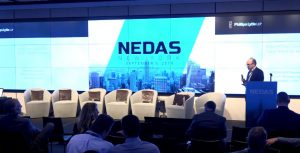With massive amounts of network equipment and deployment being discussed throughout the tech and telecom sphere to support 5G and other emerging technologies, one key factor is that all of this equipment must be housed on property. Obviously, this is not a groundbreaking realization. However, there are many facets to navigating deployments across the many types of property: private, public, roof-top, basement, conduits, light poles, etc. When equipment touches these properties, regulatory considerations appear, and as time rolls on, regulations change and grow.
To investigate the state of regulatory concerns, the 2019 NEDAS NYC Summit, an event focusing on discussion and education at the intersection of wireline and wireless, welcomed telecom infrastructure attorney David Bronston of Phillips Lytle, LLP, to the stage to deliver a presentation titled Regulatory Update: Your Need to Know.
Of course, the FCC (Federal Communications Commission) is invested in facilitating 5G deployment. As a vital stepping stone to a future filled with a host of new technologies, applications and opportunities, it is undeniable that 5G preparedness is paramount. Part of this preparation for 5G involves pre-empting cities and dense urban metros. To achieve this, the FCC has put out regulatory updates, including its small cell order in 2018, which defined what small cells are and offered fee caps and other benefits for things like small cell siting applications. This also provisioned for requirements related to zoning, land use, aesthetics and more to avoid or remediate any public discontent or harm while simultaneously lowering hurdles to deployment for companies.
To ensure competitive access to multi-tenant environments (both residential and commercial) the FCC has also proposed multiple rules for revenue sharing, building access, exclusivity access for rooftops and beyond. While it was already mandatory to provide access to competitive providers, we see that regulations are going deeper to account for DAS and other wireless deployments.
When it comes to regulation, there exists a delicate balance between ensuring the public remains relatively unaffected and ensuring that the 5G network is built up and densified appropriately on an effective timeline. As we head into the digital future, regulatory concerns and regulations on the local, state and federal levels will likely continue to shift and evolve as the deployments they provision for experience the same changes.
To get a more in-depth overview of this topic, please click here to view the entire speaking session.
To learn more about NEDAS, please visit www.nedas.com.






